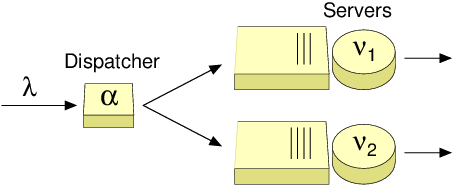Dispatching Problem: Optimal Policy
Move the mouse pointer over the figure to see how the optimal policy looks with different system parameters! |
Backlog in server 2

Backlog in server 1
|
References:
| [1] | E. Hyytiä and R. Righter, On Dynamic Size-aware Dispatching and Computation of the Optimal Actions, 2023, submitted. |
| [2] |
E. Hyytiä, P. Jacko and R. Righter,
Routing with too much information?,
Queueing Systems, vol. 100, pp. 441-443, 2022.
|
| [3] |
E. Hyytiä and R. Righter,
On Sequential Dispatching Policies,
in 32nd International Telecommunication Networks and Application Conference (ITNAC'22), 2022,
Wellington, New Zealand.
|
| [4] |
E. Hyytiä,
Lookahead Actions in Dispatching to Parallel Queues,
in 31st International Symposium on Computer Performance,
Modeling, Measurement and Evaluation (IFIP Performance 2013),
September 2013, Vienna, Austria.
|
| [5] | E. Hyytiä, Optimal Routing of Fixed Size Jobs to Two Parallel Servers, INFOR: Information Systems and Operational Research, 2013. |

